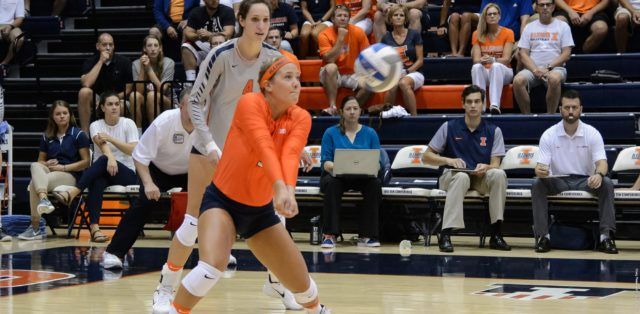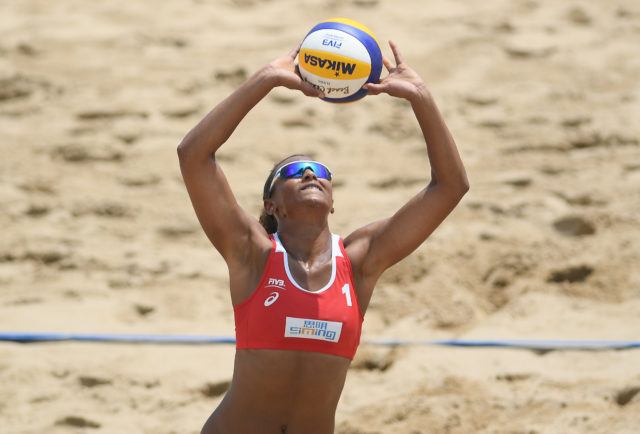So you want to be a volleyball fan? You love the staccato excitement and the rallies, but you’re not really sure what you’re watching or looking at.
As we see it, there are 3 stages of being a volleyball fan: a general awareness of the game is stage 1, an aptitude for what’s going on is stage 2, and obsession with the detail is stage 3. Of course, this is not all that there is in the world to know about the sport, but these are really the high points you need to understand the game from a fan’s perspective. After this, there’s basically two routes: either get on the court and play or start watching all of the volleyball you can to learn the names and personalities. But, that’s another story for another day.
Stage 1 – Awareness
- The first pass is crucial. The hits and the blocks get all of the attention, but a Stage 1 volleyball fan knows to watch the first pass. About 18 inches right from dead-center on the net is the perfect spot. The closer to this the first pass goes, the more successful a team will usually be.

Illinois libero passing the ball with perfect form. Photo courtesy of Illinois Athletics
- This person you are making these successful passes to is the setter. Typically, a team only has one setter on the court at a time, sometimes this is different in the case where a setter transitions into a hitter in the front row or defender in the back row with a new setter coming in. In essence, a passer will pass the ball to the setter, who will be that 18 inches right of the middle of the net.
- In a match, a team is allowed to substitute players a certain allotted number of times (depends on the level of play). To sub in a match, a player will go in front of the 10-foot line, the line closest to the center line. This allows the down referee to tell the scorekeeper of the player change. Substitutions can be strategic or something that a team regularly uses. Strategically, it can be to match up certain players, while regularly throughout a match they are used to sub out a front row player for a back row player.
- The sport of volleyball is a game of momentum, with many different influences coming into play throughout a match. A lot of top teams keep the players off the court engaged in the match through bench dances. When watching a match, take a look at the bench to see what kind of cheer they are doing for a certain point.
- While watching, you will notice a player who runs on and off the court freely (in between points) to take out a back-row player. This player wears a different colored jersey than the rest of the team to distinguish their role as the leading back row player in a match. This player is called the libero, is a defensive specialist and has different substitution rules than everyone else. The libero is usually used to replace a powerful hitter who might not be as strong on back-row defense. The libero also has limitations on how they can hit the ball – primarily, they cannot attack in front of the 10-foot line. However, they can behind the 10-foot line and if they do not break the plane of the net (jump higher than the top of the net).
Stage 2 – Aptitude
- Substitution and strategy differences in the men’s game almost always mean a 5-1 system, which means 1 setter and the option for five hitters throughout the rotations. Women’s teams will sometimes use a 6-2 system, with two setters running the offense at different times. In a 6-2, the setter will set from the back row, allowing for six hitters in throughout the rotations.
- Watch for a double touch by the setter. These are not usually obvious, as setters move too fast to catch their hands, but can be seen if a set has a lot of rotation on it. A high-rotation set almost always means a double touch by the setter.

Alex Jupiter of France setting the ball perfectly. Photo courtesy of FIVB
- Double contacts and lifts are, however, acceptable on the first contact of a serve or any other hard drive ball (attack).
- There are typically six positions on the court – Outside (left side) hitter, Middle Blocker/Hitter, Opposite (Right Side) Hitter, Setter, Libero and Defensive Specialist. An outside hitter attacks the ball on the left side of the net, the middle blocker/hitter will hit the ball from the middle with the opposite hitting the ball behind the setter on the right side of the net.
- As mentioned above, hitters will be classified as either an outside, middle or opposite side hitter. However, this does not mean that they will attack the ball from that position every time they hit, this would make the game too predictable for the other team resulting in a very vanilla offense. Often times, teams will run “trick plays” where an outside hitter will come in and attack the ball behind the middle attacker, who is going in for their normal hit, with one of the attackers posing as a decoy. In this scenario, the middle blocker is going in for a “one” while the outside is coming in for a “two”. This is just one variation of a trick play, with there being many more options available. In addition, a setter who is in the front row also has the ability to attack the ball, making things more difficult for the blockers on the opposite side of the net.
- While there are backcourt defenders, there are also defenders at the net called blockers. A blocker will try to stop a ball being attacked from crossing the net. Typically, there are two blockers that will block the ball on any given set. A higher the level of competition/skill level of players could determine a triple block system (watch Penn State women, they do this all the time). To be successful in a block, a blocker must push their hands over the net forcing the ball to the floor. In American volleyball statistics, if there are two or more blockers and they block a ball, the player will be credited with 0.5 of a block, while a solo block is recorded as 1 block. Internationally, the block is awarded to just one player.

Estonian men’s national team goes up for a triple block against Mexico’s Jorge Barajas. Photo courtesy of FIVB
Stage 3 – Obsession
- In a match, a hitter has a lot of options for where they can attack the ball. When an outside or opposite attacker goes up for a swing and it goes straight in front of them and down the closest line to them, it is called a line shot. If an attacker hits the ball to the opposite line from them, it is called a cross/angle shot.
- There are a number of different types of serves that a player can perform. Essentially, there are two, with variations to them. There is a float serve or a topspin serve. With a float serve, the player will contact the ball as to provide the smallest amount of spin possible, which is difficult to pass as it can begin to float in different directions as it passes the net. The topspin serve, while still difficult to pass because of the sheer power behind it, is easier to tell where it will land on the opposite side of the net. A player will toss the ball up in the air and try to make as much spin on the ball, forcing it to drop more quickly to the floor. Variations to these serves would be to add a jump to them. When jumping with either serve, it makes the serve more difficult to pass as there is more power behind the serve from the jump. You will see a jump float more in women’s play, while men usually go with the jump topspin serve.

Bruno Oscar Schmidt of Brazil jump serving. Photo courtesy of Chris Tanouye
- Volleyball relies on technique and form to stay consistent. Having a solid platform on a pass, keeping your elbow high on an attack, pushing over the net on a block or keeping your hands soft on a set will determine the consistency and flow of a volleyball match.

Leave a Reply